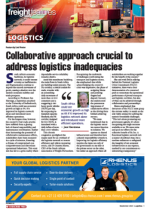The uninterrupted functioning of ports is pivotal to f lawless logistics operations. However, over recent years, South African ports have grappled with challenges that jeopardise their capacity to sustain peak efficiency and fulfil the demands of a swiftly transforming logistics environment.One of the most pressing issues the country’s ports face is the infrastructure strain. Nearly all the ports have been grappling with congestion due to increased volumes and the delays experienced as land and seaside equipment have come under pressure.Another challenge is keeping up with port facilities' necessary maintenance and upgrades. Ageing infrastructure and limited investments have resulted in outdated equipment and ill-equipped facilities that are required to handle modern shipping demands.According to Prof Micky Chasomeris of the University of KwaZulu-Natal, well-functioning ports are critical as they remain gateways to international markets.“South Africa is a major player in the seaborne trade due to its geographic location,” he said at a recent Transport Forum. Chasomeris, a maritime economist, has been involved in a study to assess the capacity and performance of marine services in South Africa.“Regrettably, at a national level, marine services at all eight commercial ports are under-capacitated and operate below the required or optimal capacity,” said Chasomeris.An assessment of Transnet National Ports Author it y’s f leet age and bollard pull highlighted some of the challenges faced in the country. “The world average age of sea-going tugs in ports is 23 to 35 years,” said Chasomeris. “An assessment of the national f leet age and bollard pull power available highlights the challenge faced by the ports and legitimises the concerns tabled by port users.”He said a lack of investment in f loating crafts, especially in the ports of Mossel Bay and East London, was apparent, where the f leet was much older than 35 years.“The average bollard pull required in port is 65 tonnes, compared with the average 54-tonne bollard pull in South African ports – an 11-tonne bollard pull power deficit.At the same time, the ports are facing severe shortages of critical skills, with the gap widening.“The study identified a total shortage of 75 personnel, translating into a shortage of 21 pilots, 28 tug masters and 26 marine engineers,” he said. “This bleak picture is worsened due to maritime training challenges. The absence of ships registered under the SA f lag and the time required to train and qualify pilots, tug masters and engineers exacerbates the mat ter.”Chasomeris said analysis over eight years revealed that over 70% of shipping delays at the Port of Durban were due to tugs being occupied (29%), shipping movements (22%), tugs out of commission (10%), adverse weather (5%) and terminal d e l a y s (4%) .“The top three shipping delays point to problems of capacity. These three categories of delays account for roughly 61% of the marine services delays,” he said. “Tugboat occupied suggests limitations in the number of tugs in ports. An increase in capacity could have a major impact on reducing shipping delays. Tugboats out of commission can be addressed through better planning and a good maintenance regime. At the same time, tug occupied and shipping movement ref lects a lack of investment to increase the number of tugboats.”Chasomeris highlighted the need for South Africa to address the capacity and performance of its ports. TNPA requires skilled seafarers, reliable equipment, best-in-class procurement systems and f lexible management systems to provide the services needed. It also needs to urgently address ageing infrastructure, a fundamental structural problem constraining the ports. “TNPA must accelerate investment in much-needed resources to support and satisfy industry demands,” he said

